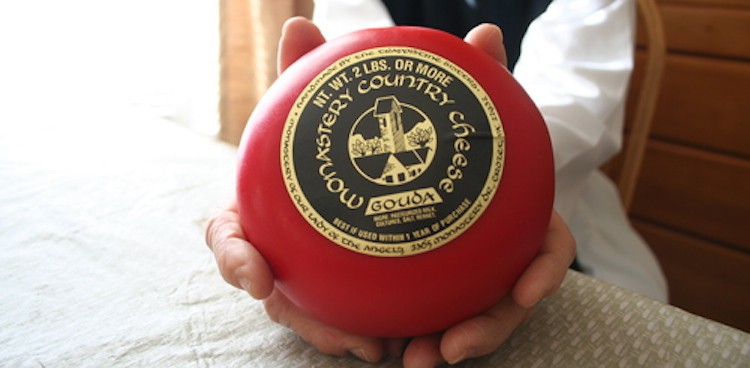
Monasteries have been known for producing their own goods since the middle ages to feed and sustain their communities of monks and nuns, and cheese has always been a popular food item to craft. Why? When unable to meat or fish due to religious reasons, cheese became quite the attractive protein. Each monastery had it’s own unique recipe for the cheeses they produced, but most recipes were closely similar in style. Today, there are cheeses made in this style in both monasteries and factories, and all are known as monastic cheeses.
Monastic cheeses are typically semi-soft cow’s milk cheeses with pungent and aromatic flavors. The rinds are washed with alcohol, a practice that developed naturally since many monasteries were also producing wine or beer.
There are many types of cheeses that have come out of the monasteries that have been developed into the more popularly produced cheeses we know today. For example, Münster takes it’s name from latin monastarium, meaning “monastery.” The cheese dates back to 1371 in Germany, where it was made by Benedictine monks. The smoking of this cheese and the periodic brine-washing of the rind gives this cheese its particular color and taste. At the end of the sixteenth century, Époisses was created in the Cistercian Monastery of Epoisses. The French epicure Brillat-Savarin once called Époisses the “king of all cheeses,” and even Napoleon claimed to be a big fan. The recipe stayed within the monastery for 2o0 years, before being passed on to the farmers within the region. One of the most well-known monastic cheeses originated in the 1800s from the Notre Dame du Port-du-Salut, the recipe travelled across Europe to Hungary and other Eastern European countries where it is more popular, as well crossing the Atlantic to North America. Through the different cultures the recipe varies, however the original recipe is still being manufactured in France under the name of Port-Salut (and, if you’re feeling adventurous, you can make your own with this DIY recipe).
Though much cheese production has moved out of monasteries and into big factories, modern day abbeys and monasteries continue to follow ancient cheesemaking practices. The sisters of the Our Lady of the Holy Angels Monastery began producing Monastery Country Cheese Gouda in Crozet, Va. in the 1990s as a way to remain self-sufficient. The six nuns who began the cheese operation in Virginia moved down south after leaving Mt. Saint Mary’s Abbey in Wrentham, Mass., another cheesemaking monastery that still uses original equipment to create authentic monastic cheeses.
The Trappist ideals emphasize self-sufficiency and manual labor, which explains why the process of cheese production appeals to the sisters. “We produce only what we need to support ourselves so that we can remain focused on our life of worship,” says Sister Barbara of Our Lady of the Holy Angels. The process is about becoming closer to God, not growing a business. The sisters keep their prices steady and have not moved to taking online orders. Instead, they sell their cheese exclusively through mail-orders or to neighbors who come knocking on the door.
Other monasteries selling products locally and online include: The Abbey of Gethsemani in Bardstown, Ky., The Abbey of Regina Laudis in Bethlehem, Conn., and The Abbey of Notre Dame du Lac, in Quebec.
Monastic cheeses are rich in history and flavor and thankfully, they are not yet lost to us. As long as there are monks and nuns who are expressing their dedication to God through hard work and delicious cheeses, we can remember some of the earliest styles and traditions of cheesemaking.
Photo Credit: Featured Image Courtesy of LancasterFarming.com


